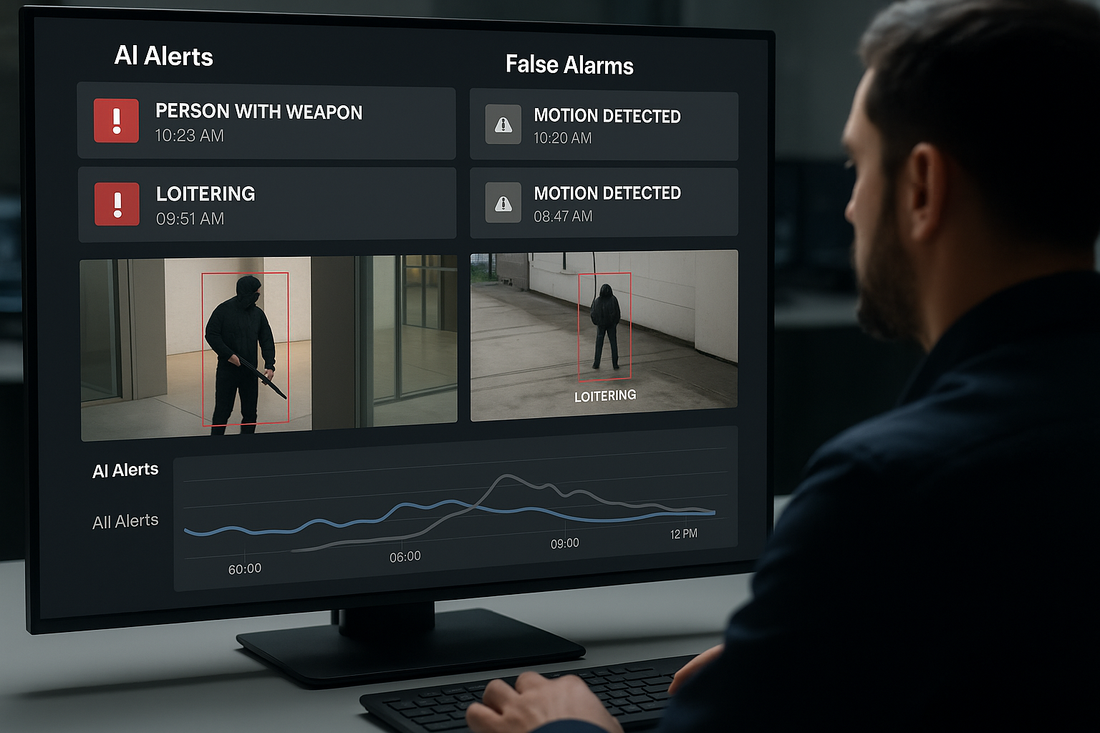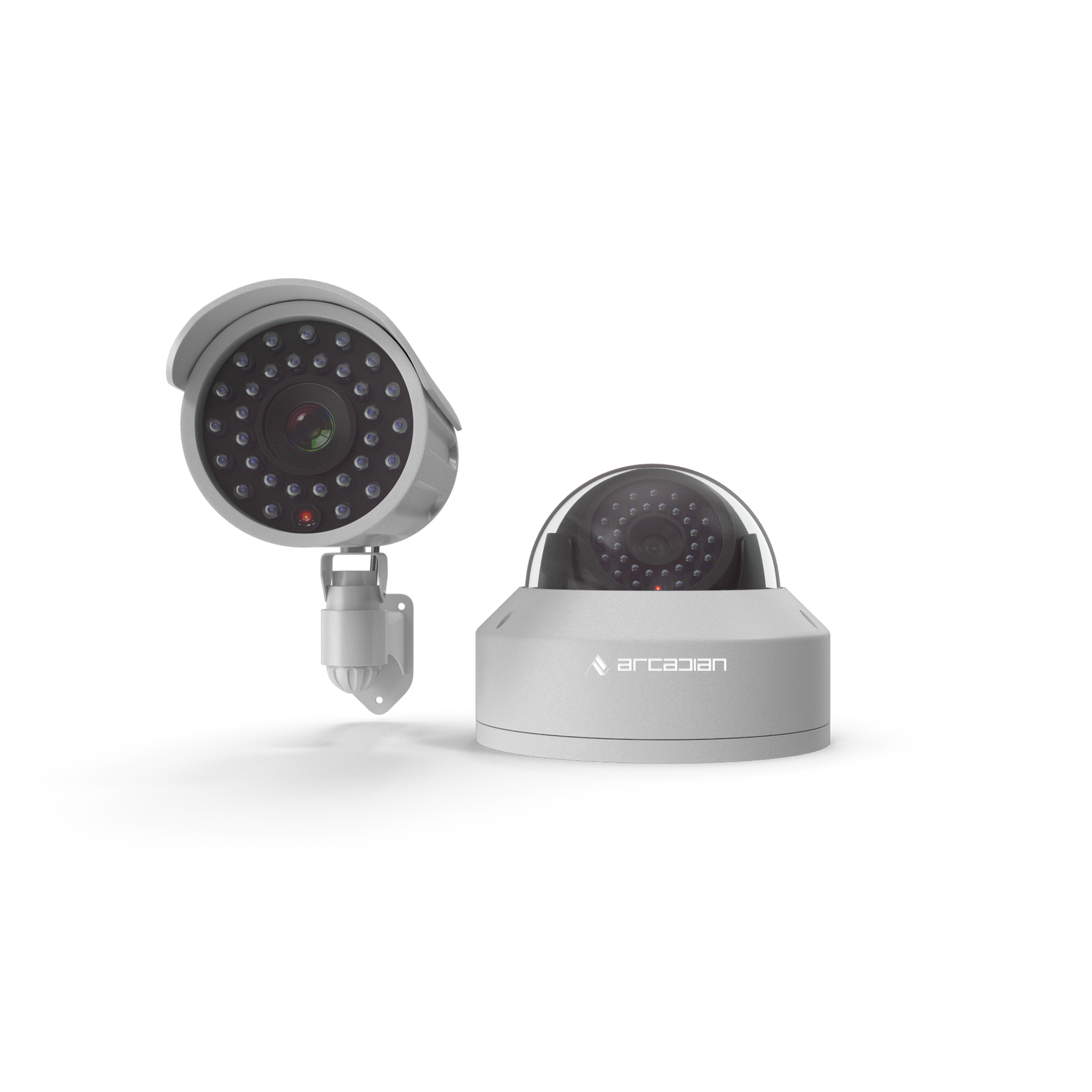AI-Driven Surveillance with Real-Time Detection & Predictive Analytics: Why Motion Detection Is Your Biggest Security Threat
Motion detection is obsolete. Predictive AI surveillance spots weapons, abnormal behavior, and risks before they escalate. ArcadianAI’s Ranger turns cameras into proactive virtual guards across retail, schools, logistics, and more.

Introduction
In 2024, U.S. police departments fielded 36 million alarm calls, with over 90% labeled false (Security Industry Association). Each false alarm wastes time, drains budgets, and erodes trust between businesses, security firms, and law enforcement. The culprit? Outdated motion detection — a technology invented in the 1970s that still dominates most surveillance systems in 2025.
Here’s the uncomfortable truth: motion detection doesn’t protect you. It betrays you. Every time a leaf blows, a shadow flickers, or a snowflake falls, your system cries wolf. Criminals exploit this noise, knowing guards, operators, and police grow numb after the 50th false alert.
ArcadianAI flips the script. Unlike static NVR vendors (Hikvision, Uniview, Hanwha) or even cloud-first providers (Verkada, Eagle Eye Networks, Genetec), Ranger uses real-time computer vision and predictive analytics to identify weapons, detect unusual behavior, and forecast risks before they escalate. Motion is noise. Behavior is the signal.
This post explores why AI-driven predictive surveillance is not just an upgrade — it’s a survival requirement. And why sticking with motion detection is the most dangerous decision you can make.
Quick Summary / Key Takeaways
-
Motion detection = false alarms, wasted money, missed threats.
-
Predictive AI detects weapons, abnormal behavior, and escalation patterns.
-
ArcadianAI reduces false alarms by 30–65% while increasing true positives.
-
Ranger integrates with existing cameras, no vendor lock-in.
-
Competitors (Verkada, Genetec, Eagle Eye) lag with static analytics.
Background & Relevance
The stakes have never been higher.
-
$100B in annual retail losses: Organized retail crime cost U.S. retailers over $100 billion in 2024 (National Retail Federation).
-
Workplace violence rising: The Bureau of Labor Statistics reported a 12% year-over-year increase in workplace assaults in 2023.
-
False alarm burden: In Dallas alone, false alarms cost taxpayers $11.6 million annually in wasted police resources (Dallas PD, 2024).
MarketsandMarkets projects the AI in surveillance market will reach $15.9B by 2028, growing at 20.5% CAGR. Demand is fueled by the recognition that static detection = static vulnerability.
Predictive analytics is transforming physical security the way antivirus transformed cybersecurity: from reactive to proactive, from passive recording to real-time defense.
Core Topic Exploration
Why Motion Detection Is a Liability
Legacy motion detection triggers on pixel shifts — not intent. That means:
-
A moth flying near a lens = alarm.
-
A plastic bag blowing across a parking lot = dispatch.
-
Snowfall = entire monitoring teams drowning in noise.
This isn’t just annoying. It’s dangerous. Every false alarm dulls operator focus, leading to missed true incidents. Criminals exploit this “alert fatigue” by blending real actions into false-positive floods.
Reverse psychology truth: If you still rely on motion detection, you don’t have a security system — you have a liability disguised as one.
How Predictive AI Actually Works
AI-driven surveillance systems like ArcadianAI’s Ranger use computer vision + predictive analytics to interpret context:
-
Weapon detection: Identifies firearms, knives, or dangerous objects before they’re brandished.
-
Behavior analysis: Flags loitering, tailgating, or unusual gait.
-
Anomaly detection: Learns baseline crowd behavior and alerts on deviations.
-
Escalation prediction: Recognizes sequences leading to theft, violence, or intrusion.
Unlike motion detection, predictive AI understands the difference between a shadow and a shoplifter.
ArcadianAI’s Secret Advantage: Ranger
Where competitors bolt AI onto cameras, Ranger works across any existing camera infrastructure. That means:
-
Camera-agnostic: Works with Axis, Hanwha, Hikvision, Uniview, Bosch, and more.
-
Cloud-native: No DVR/NVR bottlenecks or fragile on-prem hardware.
-
Context-aware: Adapts to different verticals — retail, daycare, logistics, marinas.
-
False alarm suppression: Ranger reduces false alerts by 30–65% using multi-layered AI (motion evaluation + YOLO detection + Re-ID tracking).
Simply put: Ranger doesn’t watch for motion. It watches for meaning.
Competitor Breakdown: Who’s Falling Behind
-
Verkada: Attractive UI, strong marketing — but vendor lock-in and limited AI depth.
-
Genetec: Enterprise powerhouse, but costly and complex; predictive analytics still immature.
-
Eagle Eye Networks: True cloud, but motion-based detection dominates.
-
Rhombus & Nest: SMB-focused, lack predictive insights or scalability.
-
Hanwha & Uniview: Depend on NVR-centric deployments with limited cloud-native AI.
ArcadianAI’s differentiator is freedom + intelligence: no vendor lock-in, predictive-first design, and multi-vertical adaptability.
Real-World Examples
-
Retail: A thief concealing merchandise is flagged before exit, not after.
-
Daycare: An unfamiliar adult near children triggers an escalation alert.
-
Warehouse: A forklift operating after hours sets off predictive anomaly detection.
-
Stadium: Crowd surge patterns flagged before stampede risk.
Every second gained is a life saved, a theft prevented, a liability avoided.
Comparisons & Use Cases
| Feature / Vendor | ArcadianAI Ranger | Verkada | Genetec | Eagle Eye | Hanwha NVR |
|---|---|---|---|---|---|
| Camera Agnostic | ✅ Yes | ❌ No | ❌ Limited | ❌ Limited | ❌ No |
| Predictive Analytics | ✅ Advanced | ❌ Basic | ⚠️ Some | ❌ Minimal | ❌ None |
| False Alarm Reduction | ✅ 30–65% | ❌ Minimal | ⚠️ Some | ❌ Minimal | ❌ None |
| Cloud-Native | ✅ Yes | ✅ Yes | ⚠️ Partial | ✅ Yes | ❌ No |
| Vendor Lock-In | ❌ No | ✅ Yes | ✅ Yes | ✅ Yes | ✅ Yes |
Common Questions (FAQ)
Q1. Why is motion detection still used if it’s so flawed?
Because it’s cheap and entrenched. But cheap false alarms cost more long-term.
Q2. Can ArcadianAI replace our NVR?
Yes. Ranger integrates with existing cameras and eliminates NVR bottlenecks.
Q3. What’s the accuracy of predictive AI?
ArcadianAI achieves 95%+ accuracy in weapon/behavior detection under varied conditions.
Q4. Does this increase privacy risks?
No. Ranger is NDAA/GDPR compliant and processes context, not identities, unless required.
Q5. What’s the average ROI timeline?
Most clients recover investment in 3–6 months through reduced monitoring and theft losses.
Conclusion & CTA
Motion detection is a wolf in sheep’s clothing: it looks like security but delivers risk. Every false alarm erodes trust, wastes money, and distracts from real threats. Predictive AI is not the future — it’s the new baseline.
ArcadianAI’s Ranger makes existing cameras smarter, reduces false alarms, and spots threats before they escalate. Why settle for noise when you can demand meaning?
Security Glossary (2025 Edition)
AI-Driven Surveillance — Security systems that use AI to analyze video and detect anomalies in real time.
Predictive Analytics — AI methods forecasting potential threats by analyzing patterns.
Motion Detection — Legacy system triggering on pixel shifts, prone to false alarms.
False Alarm — Non-threatening event misidentified as a security incident.
Computer Vision — AI field enabling machines to interpret and analyze visual data.
Behavior-Based Alerts — Notifications triggered by unusual human or object behavior.
Ranger (ArcadianAI) — Cloud-native, camera-agnostic AI surveillance platform.
Verkada — Competitor offering closed, vendor-locked surveillance systems.
Genetec — Enterprise VMS/access control provider with partial predictive AI.
Eagle Eye Networks — Cloud VMS provider, limited to motion detection analytics.
Hanwha — Korean camera/NVR manufacturer, strong hardware, limited AI.
Uniview — Chinese NVR vendor, low-cost, NDAA-restricted in U.S. projects.
ONVIF — Global standard for IP camera interoperability.
NDAA Compliance — U.S. law restricting use of certain Chinese surveillance brands.
VSaaS (Video Surveillance as a Service) — Cloud-based video monitoring model.
Weapon Detection — AI algorithms identifying firearms, knives, and dangerous objects.
Organized Retail Crime (ORC) — Coordinated theft rings costing billions in losses.
Loitering Detection — AI analytics flagging prolonged, unusual presence in sensitive zones.
Anomaly Detection — Identifying deviations from normal patterns in behavior or activity.

Security is like insurance—until you need it, you don’t think about it.
But when something goes wrong? Break-ins, theft, liability claims—suddenly, it’s all you think about.
ArcadianAI upgrades your security to the AI era—no new hardware, no sky-high costs, just smart protection that works.
→ Stop security incidents before they happen
→ Cut security costs without cutting corners
→ Run your business without the worry
Because the best security isn’t reactive—it’s proactive.







